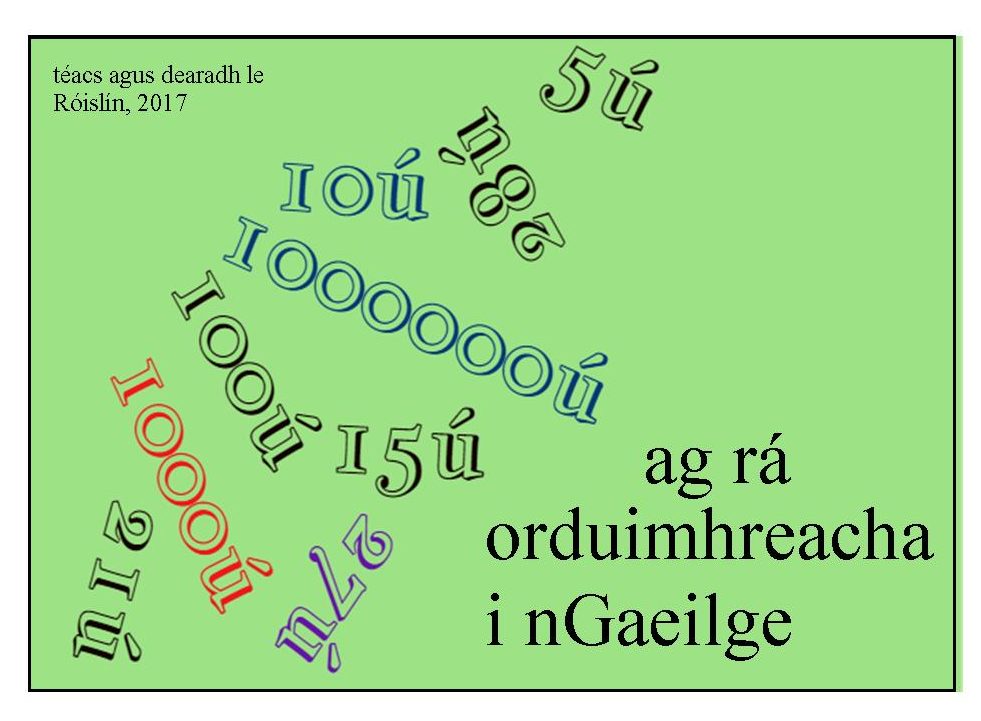Saying Ordinal Numbers Out Loud in Irish: Ag rá orduimhreacha os ard i nGaeilge Posted by róislín on Aug 13, 2017 in Irish Language
I’ve sometimes seen otherwise-confident learners of Irish come to a dead stop when they’re reading out loud and come to some numbers. The basic numbers are challenging enough. First, one must deal with all the different mutations that follow (dhá chat but seacht gcat). Then there are all the exceptions due to the “units of measurement” rules (dhá cheann but trí cinn). Additionally, one might wonder whether to say “sa bhliain míle, naoi gcéad, seasca a ceathair” (à la Ceacht 44 sa leabhar Progress in Irish) or “sa bhliain naoi déag seasca a ceathair” for “1964.” And as for situations like codáin, céatadáin, cóimheasa or suimeanna, bhuel, Dia ár sábháil!
One blogpost can’t possibly address all of those issues, but here we’ll tackle “cuid bheag den cheist,” .i. ag rá na n-orduimhreacha os ard (saying the ordinal numbers out loud).
Maybe one reason the numbers confound us so much is that we have instant recognition of the digits themselves but our brains can’t always think of the actual words for them quite as quickly. The good news, though, is that it all gets better with practice.
For today’s post, we’ll just look at a handful of examples, which like most ordinal numbers in Irish have the “-ú” ending, parallel to the “-th” in English. This is obviously not an attempt to make a complete list, just some random samples and the pronunciations for the sentences on lunar eclipses from the last blog:
an 5ú – an cúigiú, as in “an cúigiú roth,” the fifth wheel
an 10ú – an deichiú, as in “an deichiú duine sa líne,” the tenth person in line
With the teens and higher numbers, it starts to get a little more complicated because we have to remember that these actually become number phrases. For example, “15” in Irish can either be “a cúig déag” (three words) or it can be used with a noun in phrases like “cúig dhuine dhéag” (15 people) or “cúig chat déag” (15 cats), also ending up as three-word phrases. Note that the item being counted (here “duine” or “cat“) comes in the middle of the phrase. Somewhat similarly, the “ú” ending for the English “-th” is pronounced with the “5” part, not with the “teen” part, sort of as if we could imagine saying “fifthteen” [sic] instead of “fifteenth.”
an 15ú – an cúigiú ___ déag, as in “an cúigiú lá déag“, the fifteenth day, very literally, the fifth day teen
For saying numbers in the twenties out loud, we have a similar structure to the teens. The lower number comes first (here, the 1, the 7, and the 8), with the item being counted next, and with the “twenty” part (fiche) coming last. So we have:
an 21ú – an t-aonú ____ is fiche, as in “an t-aonú lá is fiche,” lit. “the first day and twenty.” This structure is very useful for saying dates out loud, as in “Beidh lánurú na gealaí le feiceáil in Éirinn ar an aonú lá is fiche de mhí Eanáir sa bhliain 2019.”
an 27ú – an seachtú ___ is fiche, as in “Beidh lánurú na gealaí le feiceáil in Éirinn ar an seachtú lá is fiche de mhí Iúil sa bhliain 2018.”
an 28ú – an t-ochtú ___ is fiche, as in “Beidh lánurú na gealaí le feiceáil in Éirinn ar an ochtú lá is fiche de mhí Iúil sa bhliain 2018.”
And for good measure, a few more, which go back to single-word numbers:
an 100ú – an céadú, the hundredth
an 1000ú – an míliú, the thousandth
an 1000000ú – an milliúnú, the millionth
Bhuel, that’ll probably not be the only time we address the issue of “ag rá orduimhreacha os ard” in this blog, but I hope it’s been a useful sample. SGF – Róislín

Build vocabulary, practice pronunciation, and more with Transparent Language Online. Available anytime, anywhere, on any device.





Leave a comment: